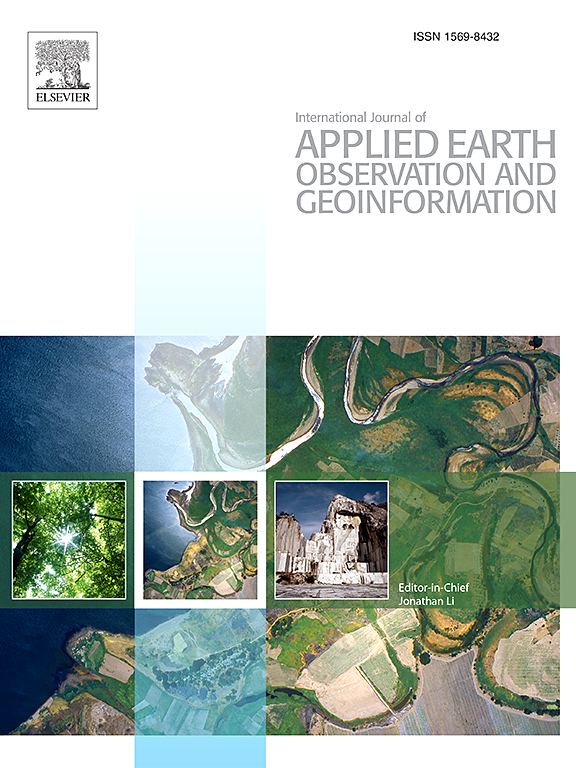Snow depth inversion and mapping at 500 m resolution from 1980 to 2020 in Northeast China using radiative transfer model and machine learning
IF 7.6
Q1 REMOTE SENSING
International journal of applied earth observation and geoinformation : ITC journal
Pub Date : 2025-04-13
DOI:10.1016/j.jag.2025.104533
引用次数: 0
Abstract
Accurate snow cover parameter assessment and mapping at a fine resolution can have profound implications for our understanding of the planet’s water balance and energy dynamics. Passive microwave (PMW) remote sensing is among the most effective methods for snow depth (SD) retrieval. However, significant uncertainties persist in SD retrieval and mapping due to snow characteristic variations, forest canopy interference, and low spatial resolution of PMW. To overcome these limitations, a novel method considering multiple influencing factors was proposed by integration a radiation transfer model with a machine learning model for SD retrieval, and a 500 m resolution SD dataset (NCSD) was generated for 1980 − 2020 in Northeast China by combining downscaling model. The validation against independent ground observations revealed that the MAE, RMSE, and R values for NCSD were 4.39 cm, 6.65 cm and 0.77, respectively. Compared to existing SD products, NCSD data effectively avoid mixed pixel issues, improved SD retrieval performance, and reveal more refined snow cover spatiotemporal patterns. Additionally, the NCSD results indicated that the annual average SD in Northeast China exhibited an increasing trend from 1980 to 2020 (0.26 cm/10a, p > 0.05). However, a notable inflection point occurred in 2000, and a subsequent decreasing trend occurred from 2000 to 2020 (0.49 cm/10a, p > 0.05). Overall, the creation of NCSD effectively filled the gap related to high-resolution SD data, and facilitated the development of hydrological studies and climate change at the basin scale.

基于辐射传输模型和机器学习的1980 - 2020年东北500 m分辨率雪深反演与制图
精确的积雪参数评估和精细分辨率的测绘对我们了解地球的水平衡和能量动态具有深远的意义。被动微波遥感是积雪深度反演最有效的方法之一。然而,由于积雪特征的变化、森林冠层的干扰以及PMW的低空间分辨率,SD的检索和制图仍然存在很大的不确定性。为了克服这些局限性,提出了一种综合考虑多种影响因素的辐射传输模型和机器学习模型的SD检索方法,并结合降尺度模型生成了1980 ~ 2020年东北地区500 m分辨率SD数据集(NCSD)。对独立地面观测数据的验证表明,NCSD的MAE、RMSE和R值分别为4.39 cm、6.65 cm和0.77 cm。与现有的SD产品相比,NCSD数据有效避免了混合像元问题,提高了SD检索性能,揭示了更精细的积雪时空格局。此外,NCSD结果表明,1980 ~ 2020年东北地区年平均SD呈增加趋势(0.26 cm/10a, p >;0.05)。2000 - 2020年出现了显著的拐点,随后呈下降趋势(0.49 cm/10a, p >;0.05)。总的来说,NCSD的建立有效地填补了高分辨率SD数据的空白,促进了流域尺度水文研究和气候变化的发展。
本文章由计算机程序翻译,如有差异,请以英文原文为准。
求助全文
约1分钟内获得全文
求助全文
来源期刊

International journal of applied earth observation and geoinformation : ITC journal
Global and Planetary Change, Management, Monitoring, Policy and Law, Earth-Surface Processes, Computers in Earth Sciences
CiteScore
12.00
自引率
0.00%
发文量
0
审稿时长
77 days
期刊介绍:
The International Journal of Applied Earth Observation and Geoinformation publishes original papers that utilize earth observation data for natural resource and environmental inventory and management. These data primarily originate from remote sensing platforms, including satellites and aircraft, supplemented by surface and subsurface measurements. Addressing natural resources such as forests, agricultural land, soils, and water, as well as environmental concerns like biodiversity, land degradation, and hazards, the journal explores conceptual and data-driven approaches. It covers geoinformation themes like capturing, databasing, visualization, interpretation, data quality, and spatial uncertainty.
 求助内容:
求助内容: 应助结果提醒方式:
应助结果提醒方式:


